
The Mulch
Something for Nothing
I took the opportunity this past autumn and winter to take some cuttings from various gardens where I work in order to expand the plant material and range available in my clients’ gardens, and providing some extra plant stock for the garden at Garreg Gron, too.
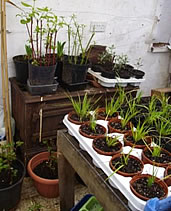 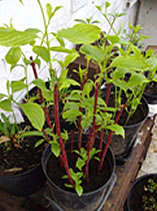
< Stick in the Mud
Prunings and cuttings are a cheap method for increasing your plant stock
This is a relatively cheap method for acquiring new plants from existing stock (so you know that it will be identical to the mother-plant) and, depending on the time of year you take cuttings and from where on the plant, you will enjoy a very high success rate.
In my potting area I have two pots of Cornus sp (Dogwood) cuttings (cut in early March as waste material) that have taken well.
To the right of the Cornus cuttings are six tip cuttings of Brachyglottis Monroi, taken last November and in the foreground are Schizostylis (Kaffir Lily) that had self-seeded and grown in a gravel pathway, now potted up.
Rounding Down to Zero…
Did you know that many plants, seeds, growing kits and fruit trees are zero-rated for VAT?
This means that you should save the 20% (standard rate) in VAT at your local garden centre and nursery on many items including: seeds for anything grown for human consumption; fruit trees that are normally grown in the UK for edible fruit; herbs grown for culinary purposes; grass seed; and mushroom growing kits in cardboard form.
In my experience there appears to be some confusion at gardening outlets over what is zero-rated for VAT and what is standard rate.
Next time you are at your local supplier, take a closer look at your receipt and make sure you are not being overcharged (however unintentionally) for some of your gardening materials. www.hmrc.gov.uk/index.htm and search for:
‘seeds and plants’
Rounding Up to Zero…
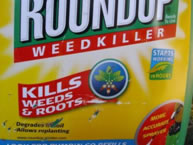 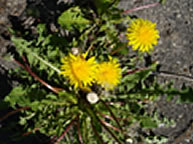 < Killer on the Loose < Killer on the Loose
Glyphosate may not be the wonder weedkiller we think it is
For many of us, using an EU-approved herbicide is a last resort, and we often justify its use by arguing that targeting the weed saves us not only time but also allows us to plant crops and shrubs that we actually want to grow in the places we’ve now cleared of weeds.
Recently, though, new information has come to light about one of the most common herbicides, Glyphosate, that will cause alarm to those of us who assumed that it was a broad spectrum systemic herbicide, becoming inert when it comes into contact with the soil.
As a systemic weedkiller, Glyphosate (N-phosphonomethyl glycine) was designed to be taken up by weeds through their leaves and stems and translocated to growing points through the inhibition of key growing enzymes. However, it is emerging that Glyphosate, a popular and widely-available weedkiller (RoundUp, Weedol Rootkill Plus, Resolva 24H) has been linked to Sudden Death Syndrome in many fields treated with RoundUp in the US.
This is because Glyphosate was originally licensed in 1964 as a chelation method for weed control. In simple terms, it acts to lock up vital nutrients in the soil and make them unavailable to the plant (and other parts of the food chain), thereby weakening them.
The problem is that this altering of the normal healthful balance between ‘good’ soil-borne nutrients and pathogens and ‘bad’ has been disrupted allowing ‘superweeds’ and pathogens such as Fusarium, Phytopthora and Pythium, which are resistant to the action of chelation, to spread unchecked.
It’s also been discovered that Glyphosate can take up to 22 years to degrade to half of its volume in soil. This has serious implications for the way we should be using Glyphosate (if at all). Spraying RoundUp and other weedkillers containing Glyphosate could be condemning that patch of our gardens to a rapidly barren condition allowing the very plants and fungi that we don’t want to encourage, to have free rein.
Similarly, if good nutrients (such as manganese, copper and magnesium) are locked up in our soils unable to be absorbed into our fruit and vegetables, what impact could that have on our nutrition and health?
www.naturalnews.com/031138_Monsanto_Roundup.html
Fridge over Troubled Waters?
Most gardeners would agree with the truism that “the weather is the boss” and, as a result, we deftly weave our work around the seasons and meteorological conditions.
But it probably will have occurred to many gardeners across most parts of the UK that we’re having to adapt more rapidly than ever to some fairly extreme weather ‘events’ and unusual climatic conditions
I alluded to the Gulf Stream in the last edition of The Mulch and this prompted me to enquire after its health. In recent years a number of articles have suggested that all is not well with the warm water ocean flow phenomenon that is believed to keep our climate at least 5˚C warmer than it should be for the latitude we are on.
The first high profile article was carried by The Times in December 2005 and reported that data from a study carried out by the National Oceanography Centre in Southampton “give the strongest indication yet that Europe's central heating system is breaking down under the impact of global warming.”
The report went on to state that the flow rate in the deep water return branch of the conveyor belt that headed back from the Arctic had decreased by 30% since the last measurements were made 13 years earlier.
When analysed alongside a reported significant decrease in deep ocean salinity levels in the same return flow, this pointed to a mixing of ocean waters with large amounts of fresh water entering the north Arctic waters.
Why would this happen? The rapid dilution of salty sea water with fresh water is most likely to be caused by glacier meltwaters flowing into the Arctic – it makes the water less dense (and heavy) and prevents the conveyor belt from sinking deeply enough and then making the return trip back down to the Gulf of Mexico.
What does this mean for us? Interestingly, the climate models suggest that current global warming effects (such as glaciers melting, higher precipitation due to warmer air temperatures and greater accumulations of snow) could lead to lower average temperatures for northwest Europe, including the UK.
Meric Srokosz, of the Natural Environment Research Council, which funded the 2005 Study, said: "The models suggest that if the change is persistent we might see … a 1C drop in temperature here over a decade or two."
Recently, amid further reports that the Gulf Stream had faltered on its journey towards the UK, an Italian theoretical scientist, Dr. Gianluigi Zangari, suggested that this could be a direct result of the oil spill in the Gulf of Mexico, the place where the Gulf Stream originates.
Other climate scientists, whilst acknowledging that there may be a “modest cooling” over northwest Europe, as a result of a slowdown in the Gulf Stream during the 21st century, argue that Europe’s climate is not as dependent on the Gulf Stream as originally believed. They cite seasonal storage and release of heat stored by oceans and atmospheric flow (of warmed air) as far more important determinants of our mild climate.
http://rads.tudelft.nl/gulfstream/
http://www.gulfstreamshutdown.com/
Cuttings…
V is for …Vespa velutina
The southern shores of the UK are on high alert for an unwelcome visitor that may cross the Channel in 2011: the Asian Hornet (Vespa velutina). Already widespread across France, this particular species of wasp is a highly effective predator of insects, and beneficial species, including honeybees, where it can quickly decimate colonies. The Asian Hornet is readily identifiable as it is not striped. Instead, it has a dark brown body and yellow tip. Please report any sightings.
http://hymettus.org.uk/information_sheets.htm
Buzz Off
Apiarists were stung by news in January that the chief executive and committee of the British Beekeeper’s Association (BBKA) had sold the rights to use the charity’s logo to four pesticide companies in Europe without telling their members. These same companies produce pesticides that have been implicated in the decline of bee colony numbers. www.britishbee.org.uk
Chocs Away!
A bar of dark chocolate should be part of your first aid cabinet, according to recent studies. The ancient Mayans understood the health benefits of cacao beans and even traded in this precious commodity. 1.4oz of dark chocolate a day was reported to reduce stress and mental fatigue in a study group over a two week period.
www.naturalnews.com
Older Than Time…
Scientists have located the oldest known plant on earth on an arid suburban hillside in California. The 13,000 year old Jurupa Oak (Quercus palmeri) currently has more than 70 stems, none more than a few feet high. It grows slowly and by sprouting after charring. www.news.discovery.com
No to NeoNicotinoids
UK invertebrate conservation charity, Buglife, wants the use of neonicotinoid pesticide, Clothianidin, to be reviewed, particularly as manufacturer, Bayer, wants to expand its use to cotton and mustard crops. www.buglife.org.uk
Between a Rock and a Hard Place…
There’s no shortage of rocks and stones here and I have recently used some to extend an existing wall and create interesting features around the garden. I’ve also set a slate seat in the curve of one wall to enjoy the views over Cardigan Bay, some 6 miles away.
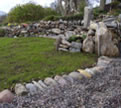 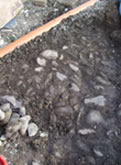
< Take a Seat
This wall carries a seat to look out to Cardigan Bay
> Under the Surface
An old cobbled surface comes to light
Excavating a trench for a new gulley drain has also revealed the cobbled surface of an earlier path.
|

